Primary Drive Gear Replacement
Special Instructions
This procedure provides instructions for replacing the Primary Drive Gear and Rail C Sliding Clutch.
- Primary Drive Gear (S-3206)
- Rail C Sliding Clutch (10000557)
- I-Brake MTM to Main Housing O-ring (13653)
- I-Brake Main Housing to Clutch Housing O-ring (13834)
Special Tools
- Rear Housing Alignment Pins (RR1090TR)
- Upper Countershaft Pilot Tool (RR1071TR)
- Lower Countershaft Pilot Tool (RR1072TR)
- Mechanical Diagnostic Kit (RR2011TR)
- Gasket Sealant (Loctite 5188)
- Transmission Assembly Lube (Lubegard® Assemblee Goo Firm Tack - Green #19250 or equivalent)
- Plastic Scraper
- Gasket Remover (Non-Chlorinated Brake Cleaner)DangerCaution
Component Identification
 | |
1. Main Housing External Cap Screws (x19) - 16 mm 2. Main Housing 3. Main Housing Internal Cap Screws (x6) - 16mm | 4. Rear Housing Alignment Pins (RR 1090TR) 5. Rail C Sliding Clutch 6. Primary Drive Gear |
Create a Service Activity Report
Note: If not already created and sent.
Key on with engine off.
Connect ServiceRanger and create a Service Activity Report.
Select “Send to Eaton” (internet connection required)
Disconnect ServiceRanger.
Key off.
Drain Oil
Locate the Oil Drain Plug on the back of the rear housing.
Place a suitable container under the Oil Drain Plug.
Note: If reusing oil, use a clean container free of contamination and debris.
Remove the Oil Drain Plug with a 6 mm hex key and drain the oil.
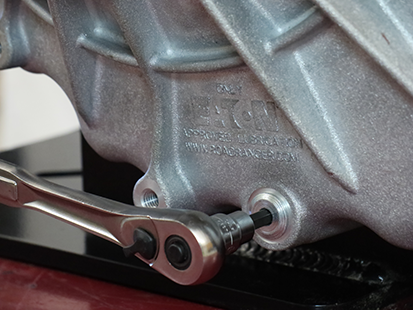
If PTO-equipped, remove PTO and drain the oil.
Inspect Oil Drain Plug and O-ring for damage. If damaged, replace the Oil Drain Plug; O-ring is serviced with plug.
Install the Oil Drain Plug (6 mm) and torque to 24.5-29.5 Nm (18-22 lb-ft).
Notice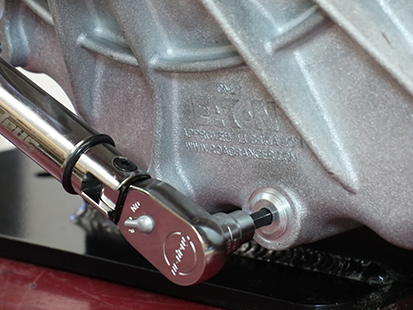
Manually Vent Linear Clutch Actuator (LCA)
Key off.
Set vehicle parking brake and chock wheels.
WarningLoosen the 4 Linear Clutch Actuator (LCA) cap screws 1-2 turns each with a T45 Torx.
Note: Residual air pressure in the LCA cylinder exhausts between the LCA and Mechatronic Transmission Module (MTM) housing when the cap screws are loosened.
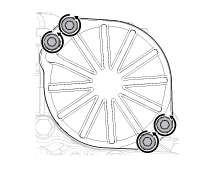
Tighten the 4 LCA to MTM T45 cap screws and torque to 23-27 Nm (17-21 lb-ft).
Remove Transmission
Disconnect negative battery cable.
Refer to OEM guidelines for transmission removal.
Remove Release Bearing and Clutch Release Yoke
Remove the Release Bearing by sliding the bearing off the input shaft.
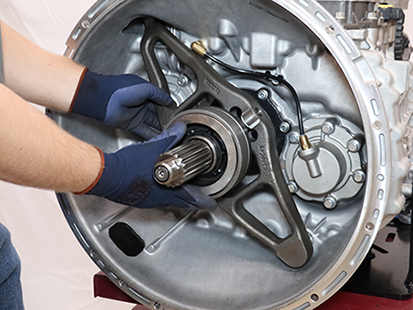
Pull to free the lower Clutch Release Yoke socket from the lower pivot on the clutch housing.
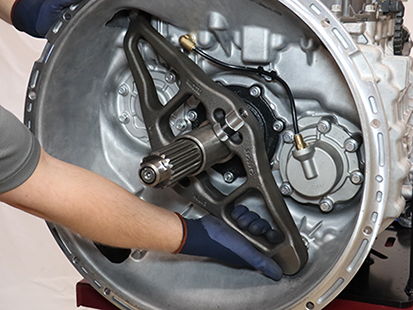
Pull to free the upper Clutch Release Yoke socket from the Linear Clutch Actuator (LCA) rod end.
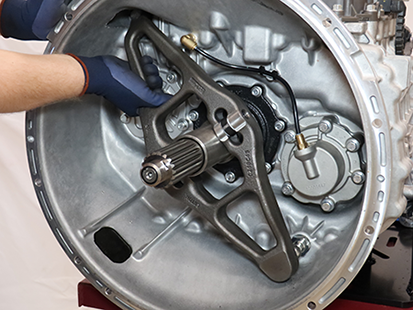
Inspect the plastic socket inserts in the Clutch Release Yoke to verify none of the fingers are missing or damaged.
Note: If the plastic insert is damaged, replace the Clutch Release Yoke Assembly and the Release Yoke Pivot Pin.
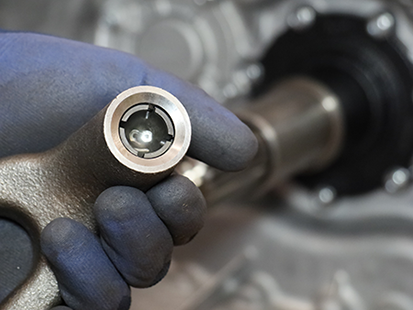
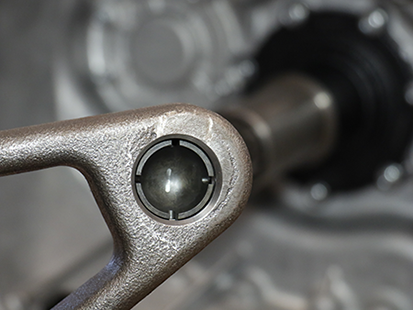
Remove Transmission Control Module (TCM)
Unscrew the 4 TCM Cover nuts and remove TCM Cover.
Note: TCM Cover nuts are 10 or 13 mm.
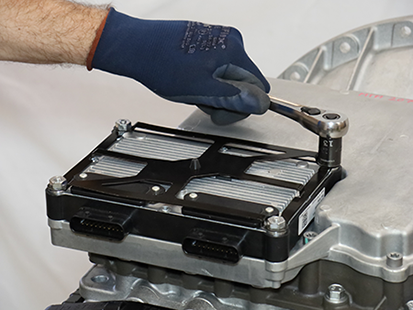
Unscrew the TCM 7 mm Jackscrew. Lift and remove the TCM from the MTM.
Notice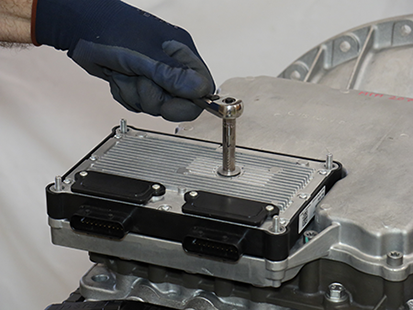
Inspect the TCM Seal for damage.
Notice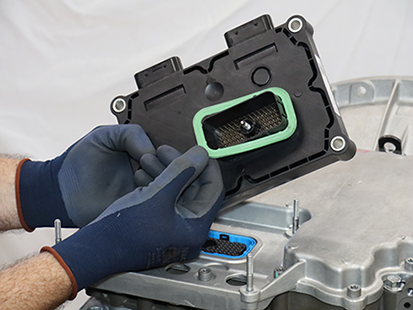
Remove Mechatronic Transmission Module (MTM)
Lift the latch on the Output Speed Sensor Harness at the Connector on the Mechatronic Transmission Module (MTM).
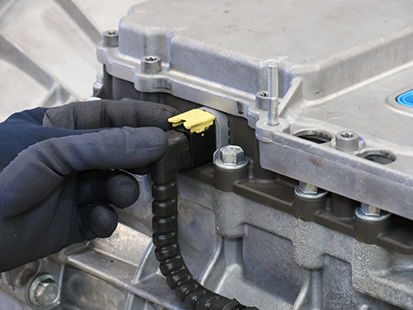
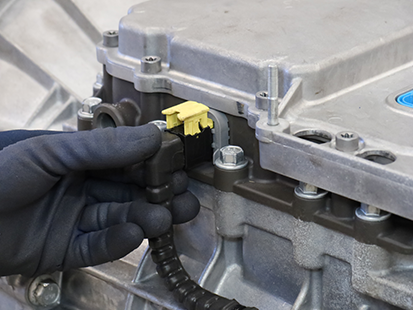
Remove the Output Speed Sensor Harness from the Connector on the MTM.
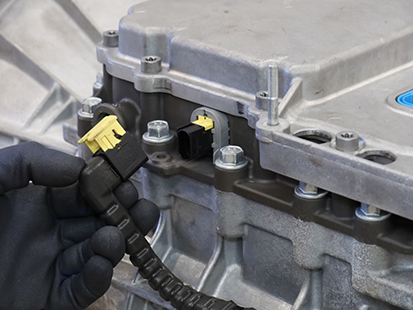
Remove the 20 MTM cap screws.
Note: 13 mm (x18), 15 mm (x2).
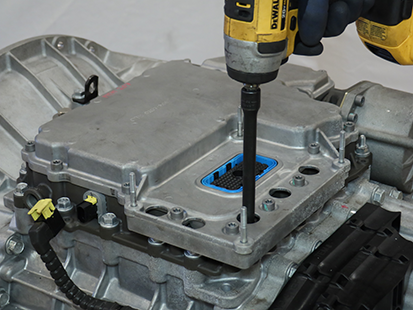
Separate the MTM from the Main Housing at the 2 pry points.
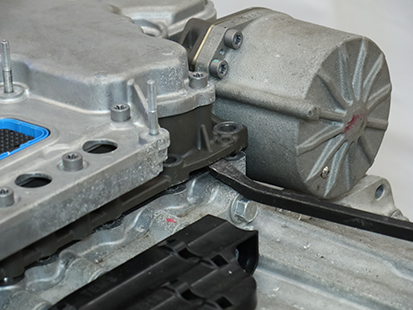
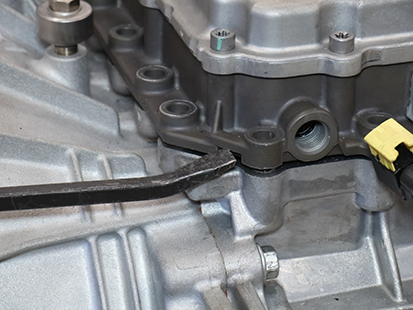
Remove the MTM from the transmission housing.
Caution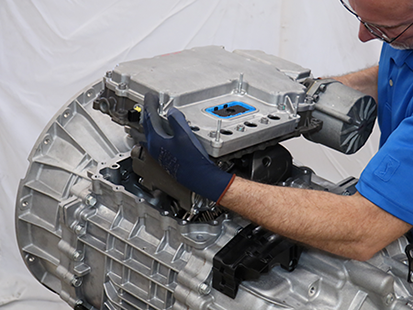
Remove Output Speed Sensor
Remove the Output Speed Sensor Harness tie strap at the Harness Bracket.
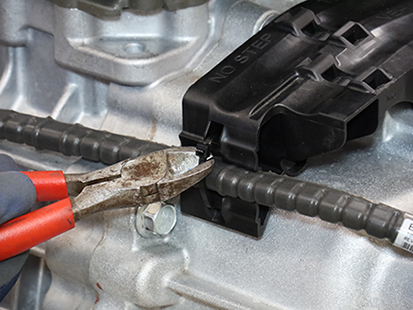
Remove the 2 harness press-in retainers from the Main Housing and bracket on Rear Housing.
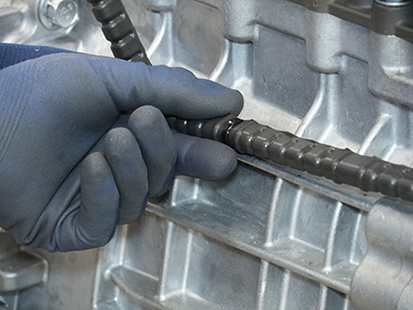
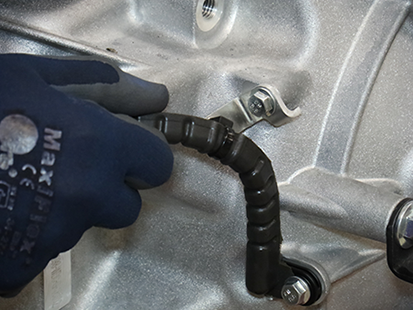
Remove the Output Speed Sensor 10 mm cap screw.

Remove the Output Speed Sensor from the Rear Housing.
Note: The sensor may need to be twisted and pulled from the bore.
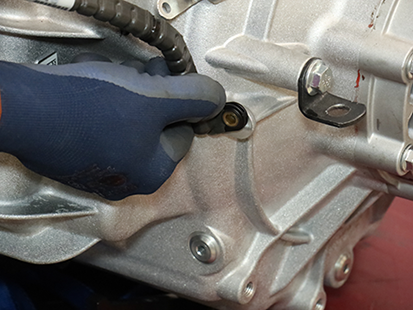

Remove Harness Bracket
Remove the Output Speed Sensor Harness tie strap at the Harness Bracket.

Remove 3 Harness Bracket 10 mm cap screws.
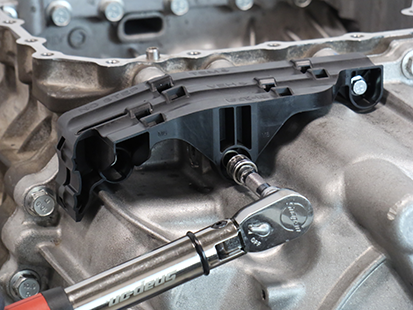
Remove Harness Bracket.
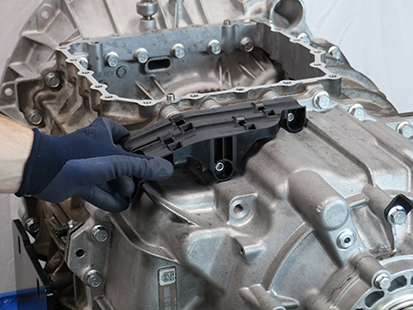
Secure Transmission (Vertical)
Place transmission in the vertical position with the front side down.
WarningNoticeNote: Use a surface with an opening that allows the input shaft to pass through and the clutch housing to sit flat and secure.
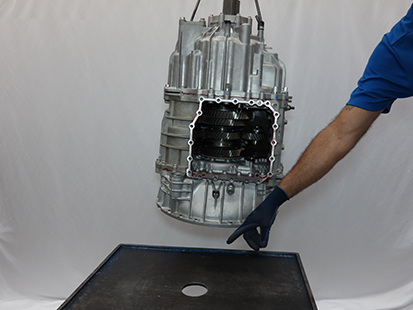
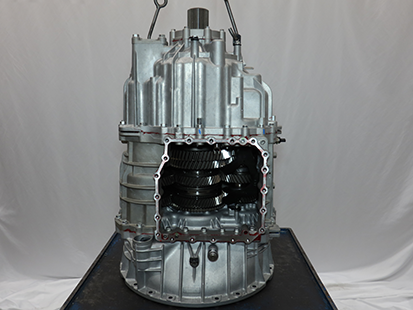
Remove Rear Housing
At the 3 Rear Housing Threaded cap screws, apply paint marks on the Rear Housing to identify location.
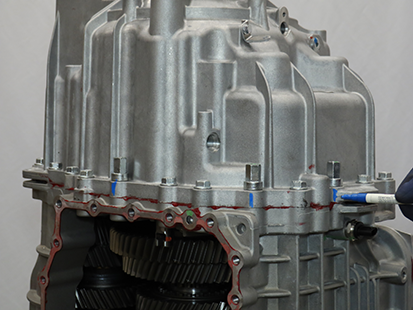
Remove 21 Rear Housing and 3 threaded 16 mm cap screws.
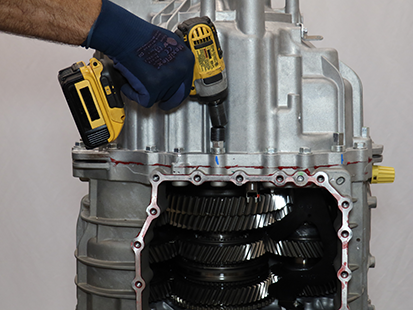
Install and hand tighten 2 Rear Housing Alignment Pins (RR1090TR) 180-degrees apart.
Notice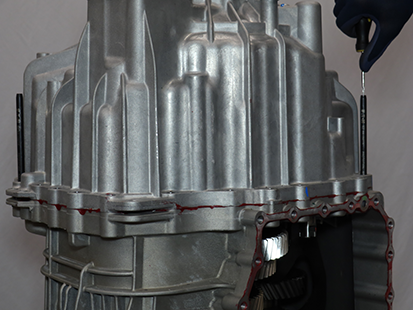
Separate the Rear Housing from the Main Housing at the 2 pry points.
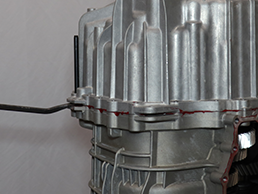
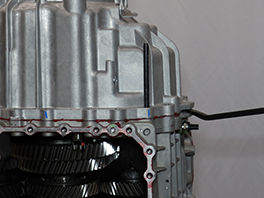
Lift and remove Rear Housing Assembly from Main Housing.
WarningNoticeNote: Dual PTO Transmissions are equipped with a rear PTO lube tube port on the pump and rear PTO drive splines on the Upper Countershaft.
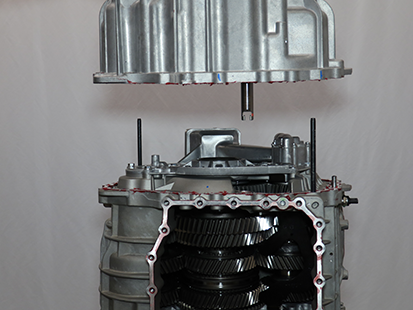
Place Rear Housing Assembly on bench.
WarningNotice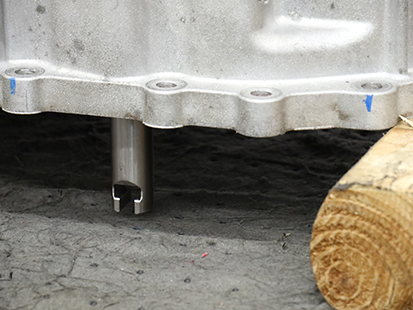
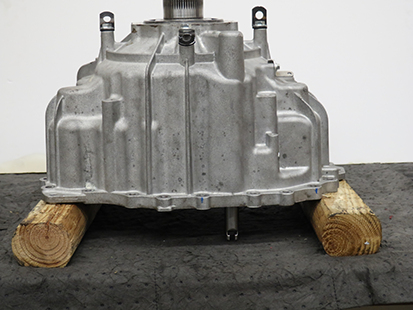
Remove the 2 Rear Housing Alignment Pins (RR1090TR) from the Main Housing.
Remove Oil Pump Assembly
Remove 18 Oil Pump Assembly 13 mm cap screws.
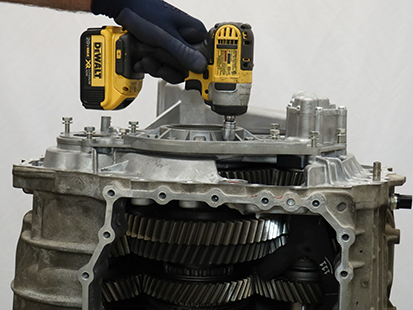
Remove Oil Pump Assembly.
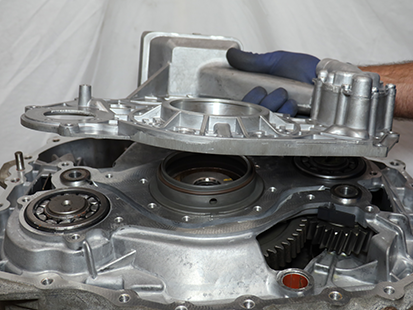
Remove Oil Pump/Range Spacer with O-ring.
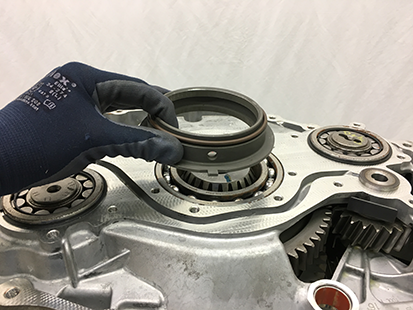
Remove Main Housing
Remove the 19 external and 6 internal Main Housing 16 mm cap screws.
Notice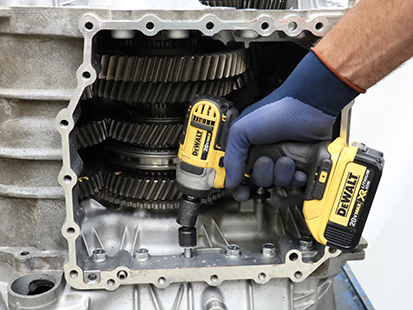
Install and hand tighten 2 Rear Housing Alignment Pins (RR1090TR) in the internal Main Housing cap screw outer threaded holes.
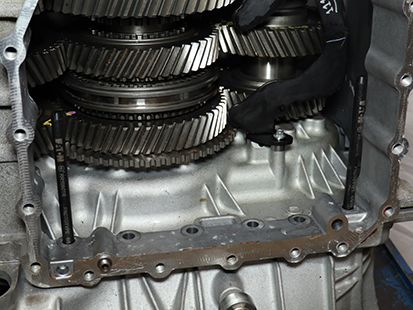
Remove 2 Rear Housing 90-degree Lifting Eye 15 mm cap screws from Rear Housing.
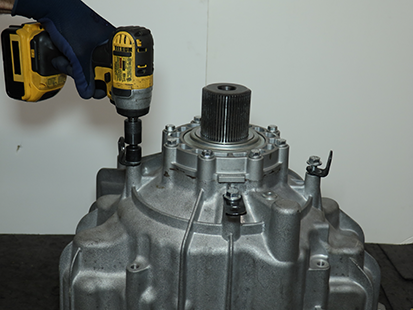
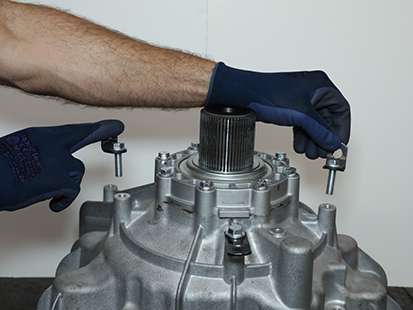
Install and hand tighten 2 Rear Housing 90-degree Lifting Eyes and 15 mm cap screws to Main Housing.
NoticeNote: Install 90-degree Lifting Eyes 180-degrees apart to ensure even lifting.
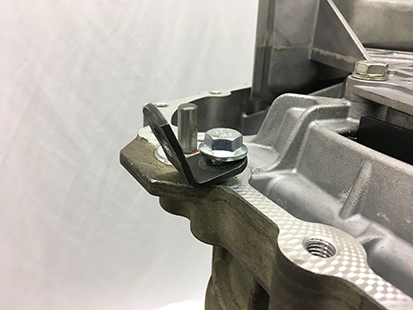
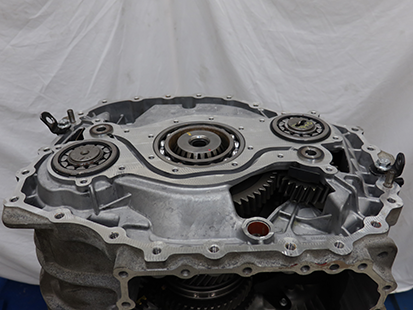
Separate Main Housing from Clutch Housing at the 2 pry points.
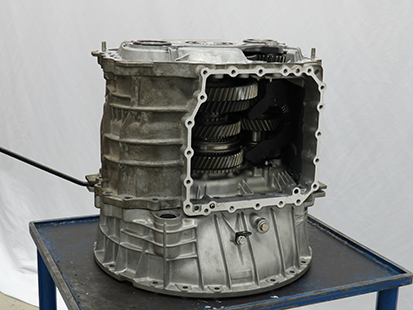
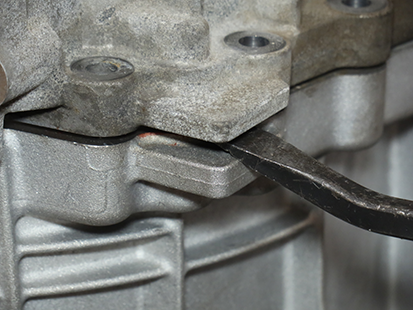
Lift and remove Main Housing from Clutch Housing.
CautionNotice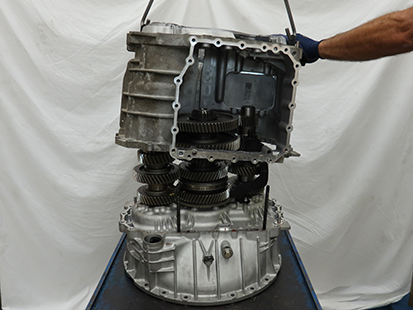
Remove Main Shaft and Countershaft
Install a magnet onto Main Shaft Key to ensure the key stays in place during Main Shaft Removal and Installation.

Hold Rail C Sliding Clutch against Secondary Driven Gear and lift Main Shaft from Primary Drive Gear.
CautionNote: Spring and Washer may remain attached to the Main Shaft during removal.
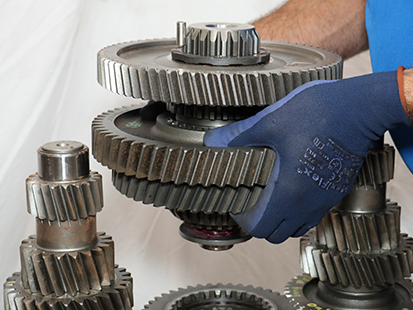
Remove Wave Spring - Rear.

Remove Thrust Washer - Rear.
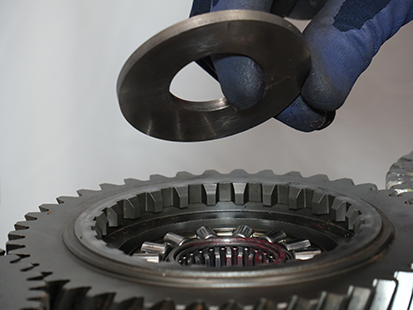
Remove Thrust Bearing - Rear.
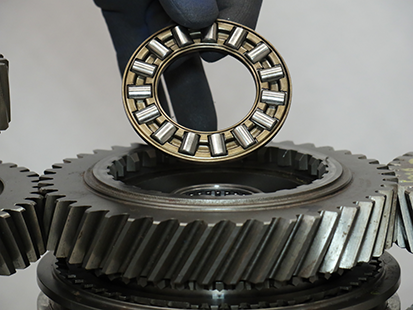
Remove Needle Bearing - Rear.
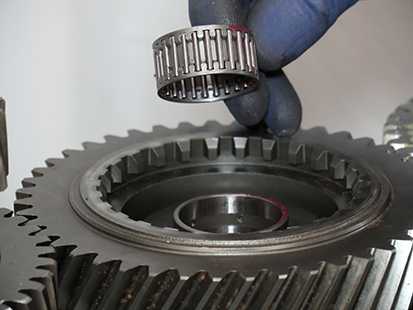
Remove Bearing Race - Rear.
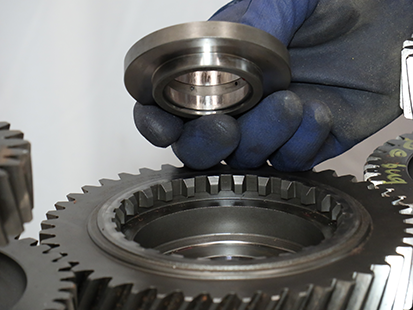
Remove Primary Drive Gear.

Install Primary Drive Gear
Install new Primary Drive Gear onto Rail B Synchronizer.
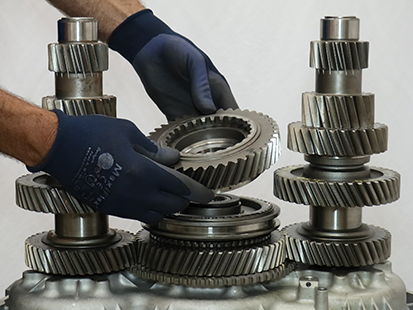
Install Bearing Race - Rear.
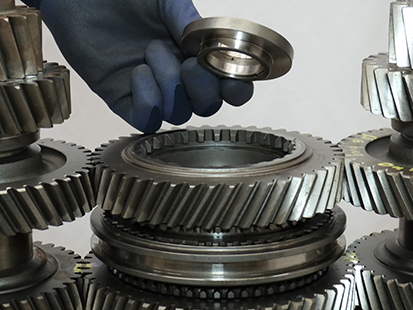
Install Needle Bearing - Rear.
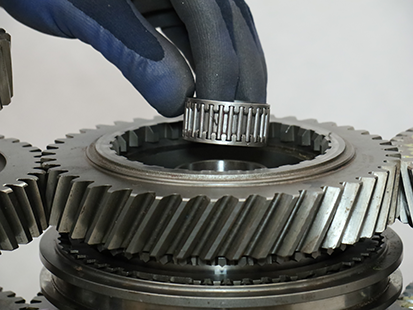
Install Thrust Bearing - Rear.

Remove Rail C Sliding Clutch
Place Main Shaft Assembly horizontally on a clean flat surface.
CautionIf necessary, remove Thrust Washer - Rear and Wave Spring - Rear.
Remove Rail C Sliding Clutch.
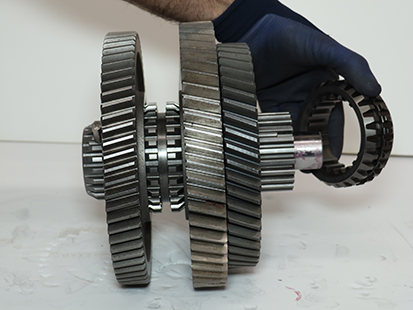
Install Rail C Sliding Clutch
Install new Rail C Sliding Clutch and align the double slot with Main Shaft Key.
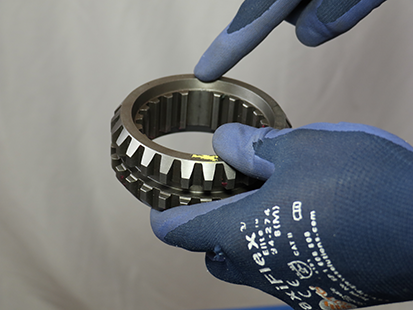
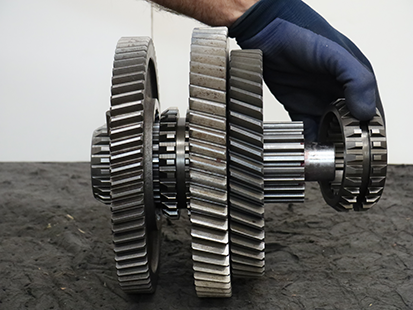
Apply transmission assembly lube to Wave Spring - Rear and install to Main Shaft.
NoticeNote: Transmission assembly lube holds Wave Spring - Rear in place during Main Shaft Assembly installation.

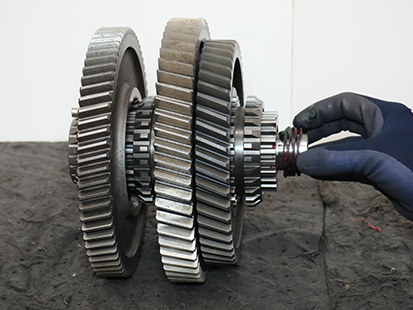
Apply transmission assembly lube to Thrust Washer - Rear and install to Main Shaft.
Note: Transmission assembly lube holds Thrust Washer - Rear in place during Main Shaft Assembly installation.
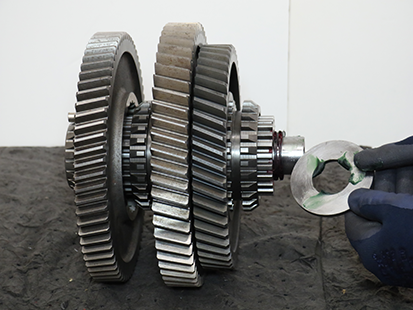

Install a magnet onto the Main Shaft Key.
Note: The magnet holds the key in position during Main Shaft Assembly installation.
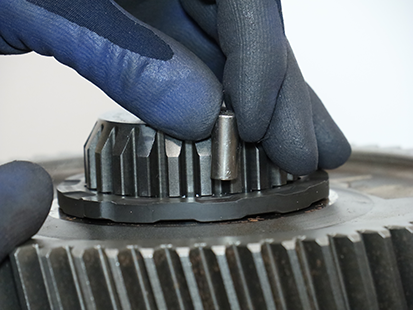
Slide and hold Rail C Sliding Clutch into Secondary Driven Gear.
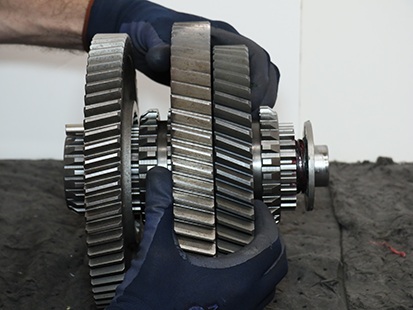
Install Main Shaft Assembly onto Primary Drive Gear and align gearing.
Caution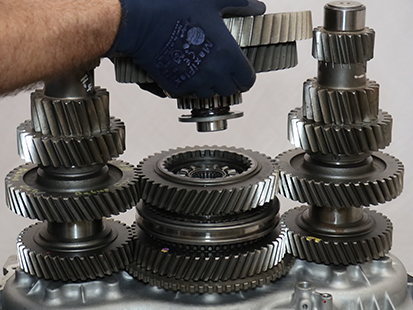
Remove magnet from Main Shaft Key.
Notice
Install Main Housing
Clean the sealing surfaces on the Clutch Housing and Main Housing with gasket remover and a plastic scraper. Let air dry then wipe with a clean dry cloth.
NoticeInspect threaded bolt holes for debris and clean if necessary.
NoticeSlide new I-Brake Main Housing to Clutch Housing O-ring (13834) over the Clutch Housing Inertia Brake air passage alignment pin until fully seated in groove.
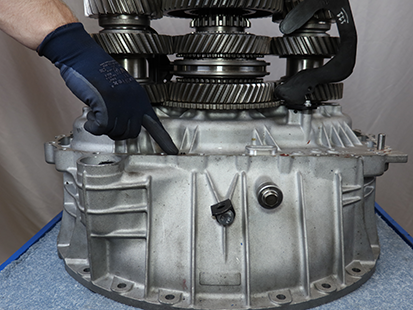
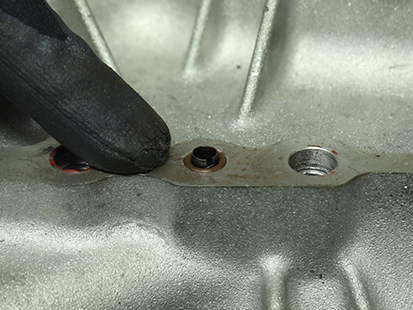
Apply Gasket Sealant with a bead width of 1.4-2.4 mm (0.055-0.094 inch) to clutch housing as shown in pattern below.
NoticeNote: Parts must be assembled within 10 minutes of applying Gasket Sealant.
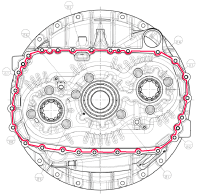
Install Lower Countershaft Pilot Tool (RR1071TR) onto Lower Countershaft above rear bearing race.
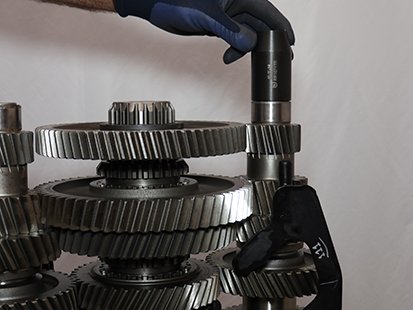
Install Upper Countershaft Pilot Tool (RR1072TR) onto the Upper Countershaft above rear bearing race.
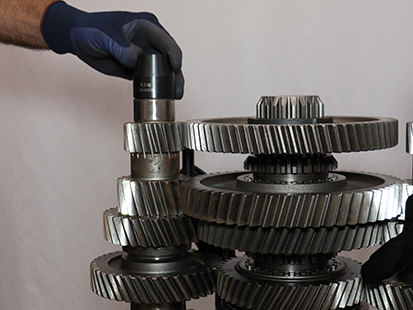
Install and hand tighten 2 Rear Housing 90-degree Lifting Eyes and 15 mm cap screws to Main Housing.
NoticeNote: Install 90-degree Lifting Eyes 180-degrees apart to ensure even lifting.

Install and hand tighten 2 Rear Housing Alignment Pins (RR1090TR) into the Clutch Housing as shown below.

Lift, align and install Main Housing to Clutch Housing.
CautionNoticeNote: Using a flat tipped screwdriver, rotate the Reverse Idler Gears to align the gearing and allow Main Housing to fully seat onto the Clutch Housing.
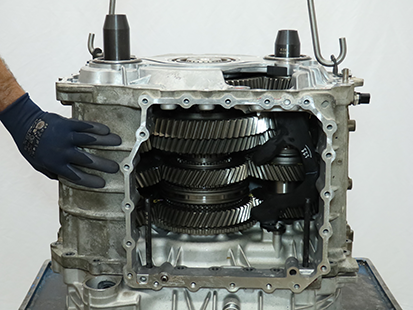
Remove 2 Rear Housing Alignment Pins (RR1090TR).
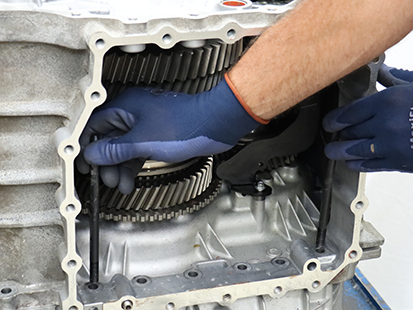
Remove 2 Rear Housing 90-degree Lifting Eyes and 15 mm cap screws from Main Housing.
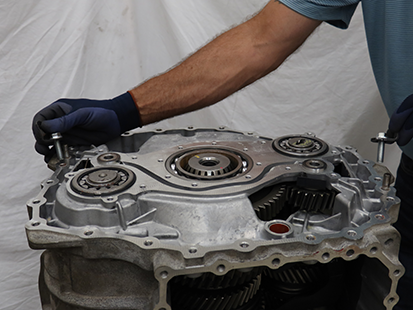
Re-install 2 Rear Housing 90-degree Lifting Eyes to the Rear Housing and torque to 49.6-55.5 Nm (36-40 lb-ft).
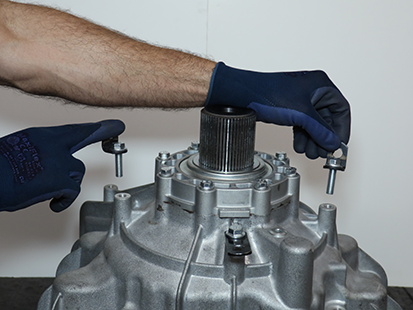
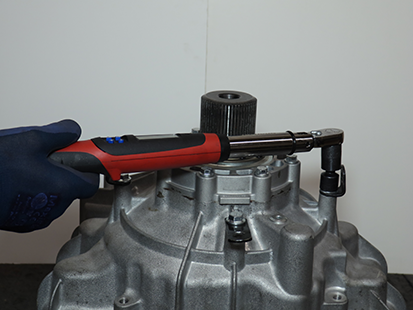
Install 19 external and 6 internal Main Housing 16 mm cap screws and torque to 44–51 Nm (33–38 lb–ft) in a criss-cross pattern.
Notice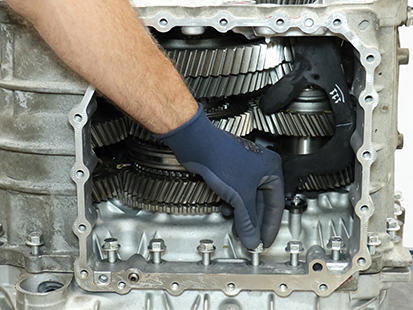

Install Oil Pump Assembly
Install O-ring to the Oil Pump/Range Spacer.
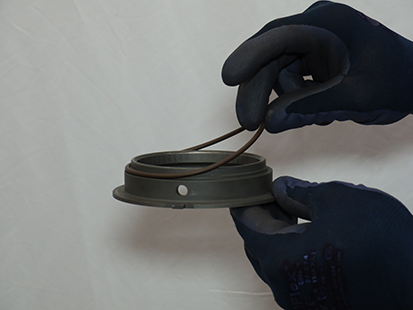
Install Oil Pump/Range Spacer with O-ring and align tab with groove in Oil Pump Assembly.
Notice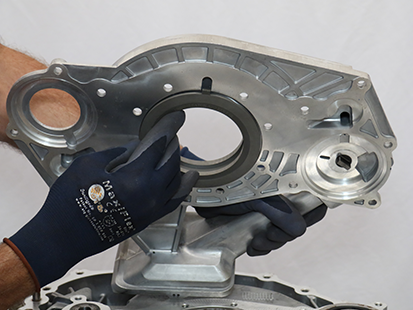
While holding the Oil Pump/Range Spacer in place, align oil pump drive key with slot on Lower Countershaft and install Oil Pump Assembly to Main Housing.
CautionNotice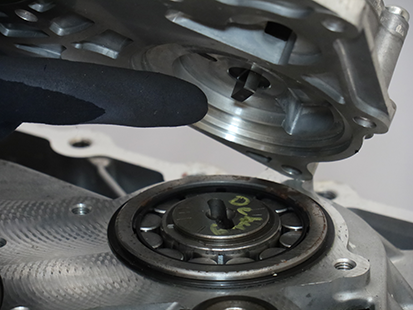
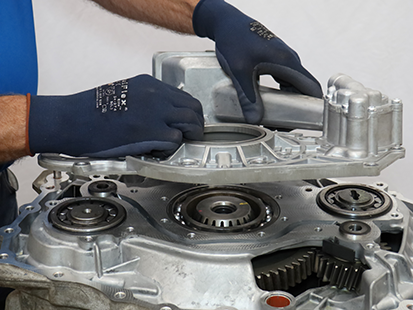
Press Oil Pump Assembly to ensure it sits flat on Main Housing sealing surface.
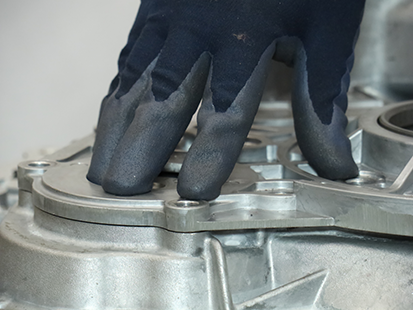
Install 18 Oil Pump Assembly 13 mm cap screws and torque to 21–23 Nm (16–18 lb–ft) in a criss-cross pattern.
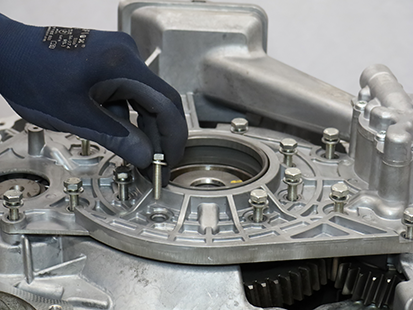
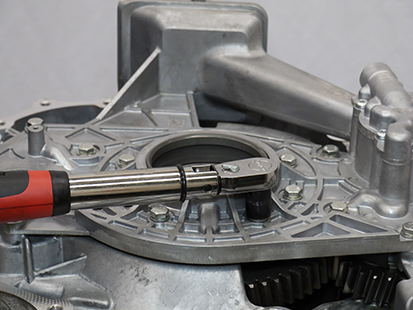
Install Rear Housing
Clean the sealing surfaces on the transmission Main Housing and Rear Housing with gasket remover and a plastic scraper. Let air dry then wipe with a clean dry cloth.
NoticeInspect threaded bolt holes for debris and clean if necessary.
Apply Gasket Sealant with a bead width of 1.4-2.4 mm (0.055-0.094 inch) to the transmission Main Housing sealing surface following the pattern below.
NoticeNote: Parts must be assembled within 10 minutes of applying Gasket Sealant.
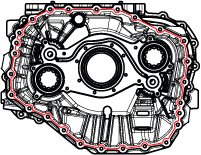
Install and hand tighten 2 Rear Housing Alignment Pins (RR1090TR) 180-degrees apart.
Caution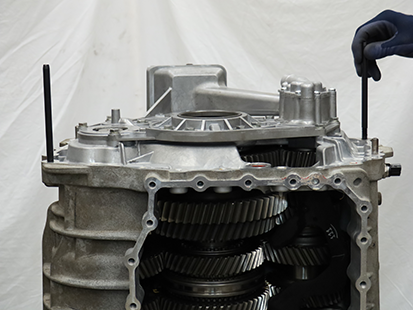
Lift and install the Rear Housing Assembly on to the Main Housing.
WarningNoticeNote: Align the Rear Housing to the alignment pins and align Shift Rail E into the Main Housing during installation.
Note: Rotate Output Shaft to align gearing and allow Rear Housing Assembly to fully seat on Main Housing.
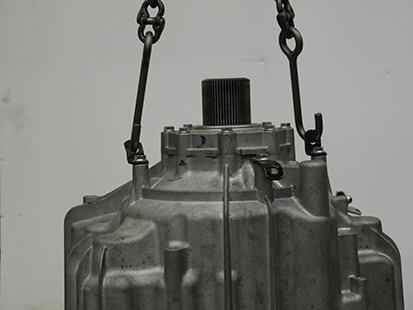
Install the 3 Rear Housing Threaded 16 mm cap screws at the 3 paint mark locations.
Note: Two cap screws are used to mount the harness bracket and the third is used by the OEM for additional attachment points.
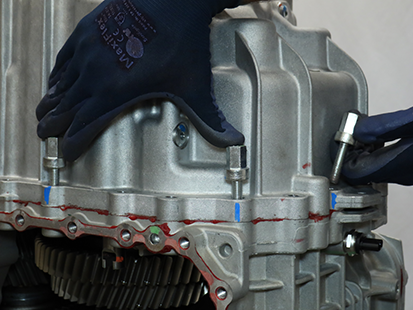
Install Harness Bracket
Note: This procedure contains installing the Harness Bracket without the Mechatronic Transmission Module (MTM).
Install Harness Bracket

Install 3 Harness Bracket 10 mm cap screws and torque to 8.8-10.4 Nm (6-8 lb-ft).

Install Mechatronic Transmission Module (MTM)
Place the transmission in a horizontal position.
NoticeClean the sealing surfaces on the transmission and Mechatronic Transmission Module (MTM) with Gasket Remover.
NoticeInspect threaded bolt holes for debris and clean if necessary.
NoticeInstall the Rail B Engagement Tool (RR1088TR) to the Main Housing and hand tighten with 2 MTM cap screws.
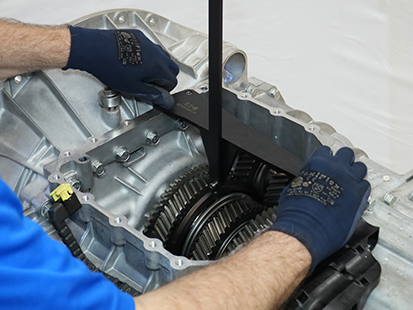
Shift the Rail B Synchronizer to neutral.
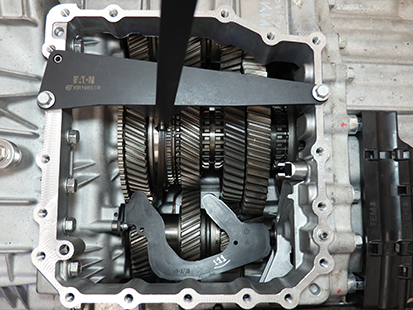
Remove the Rail B Engagement Tool.
Move Rail C and Rail D sliding clutches to neutral.
Notice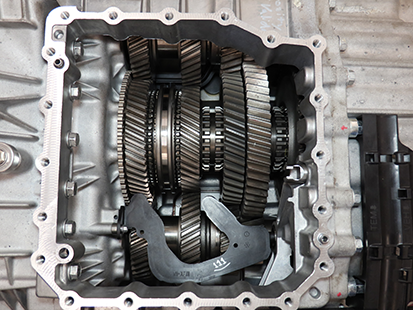
Install the Confirm-Neutral Gauge (RR1086TR-2) into the slots of the synchronizer and sliding clutches.
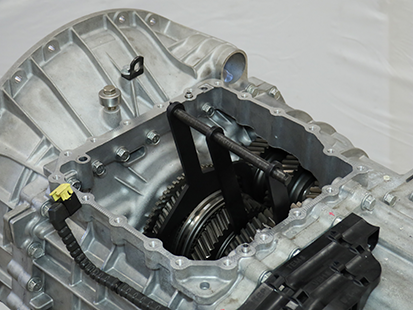
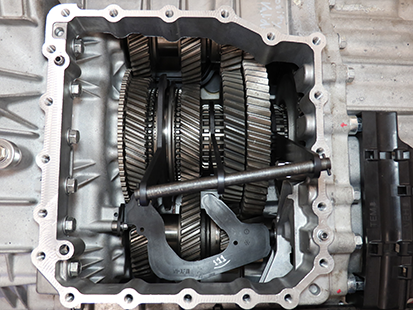
Install the MTM Alignment Tool (RR1086TR-1) onto the main housing.
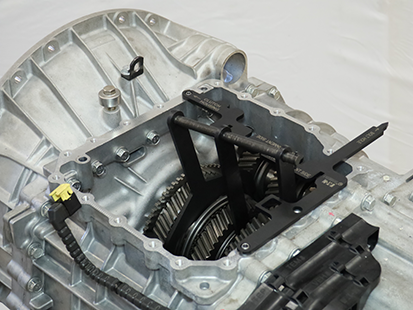
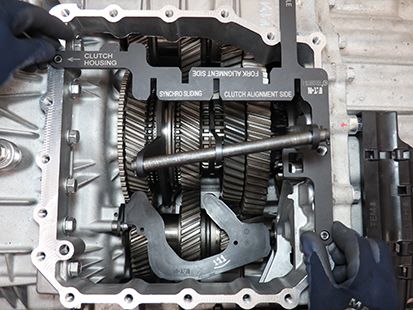
Verify synchronizer and sliding clutches are in neutral by sliding Confirm-Neutral Gauge into the slots of MTM Alignment Tool.
Note: If the gauge does not slide into the alignment tool slots, neutral is not achieved. Go to Step 4.
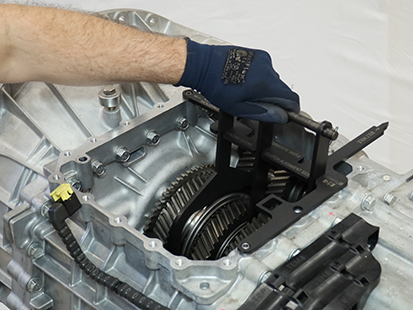
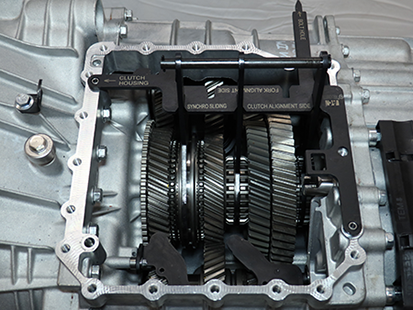
Using the Rail E Lever, move Rail E to neutral.
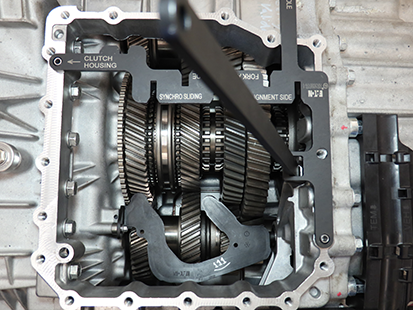
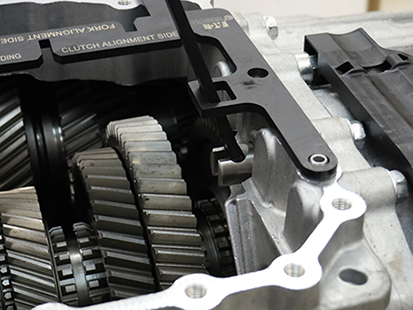

Verify Rail E is in neutral using the Gear Side Actuator end of the Confirm-Neutral Gauge (RR1088TR-2) at Shift Rail E. Rail E is in neutral when end of gauge rests against housing with rail against notch-end of gauge.
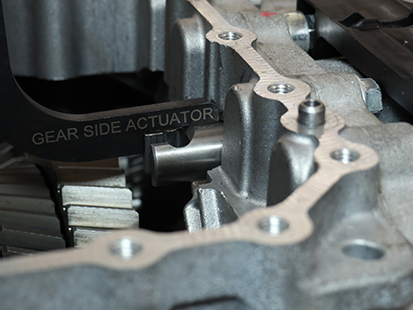
Move Shift Rail B in the MTM to neutral. Rail B is in neutral when the ball detent is in the notch of the Rail B yoke assembly.
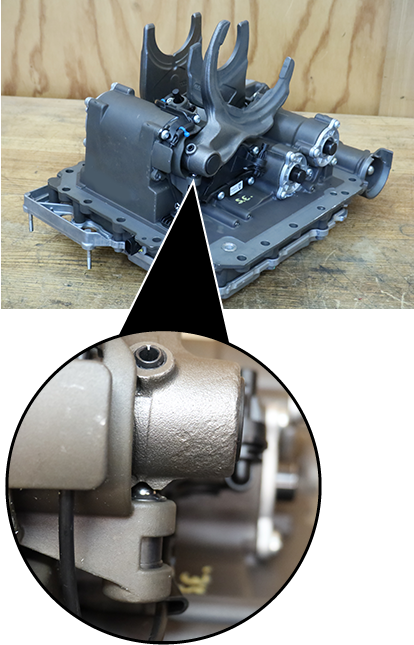
Move Shift Rails C and D in the MTM to neutral. Rails C and D are in neutral when the shift inter-lock is aligned with the notches of the rail yoke assemblies.
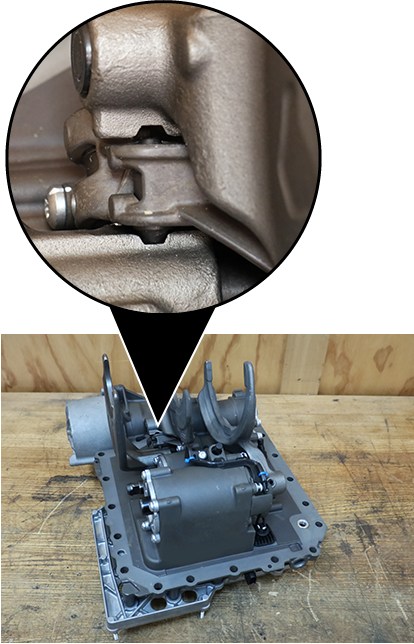
Verify MTM is in neutral. Install the MTM Alignment Tool (RR1086TR-1) into the bolt hole and onto Rail B, C, and D Shift Yokes.
Note: If the MTM Alignment Tool slots do not align with the 3 shift yokes, neutral has not been achieved. Go to Step 13.

Verify notch on Rail E is facing up.
Note: If the MTM is installed on the transmission with the notch on Rail E facing down, Fault Code 320 (SPN 5942) sets Active and the transmission will not shift out of neutral.

Verify Rail E is in neutral using the Fork Side Actuator end of the Confirm-Neutral Gauge (RR1088TR-2) at Shift Rail E. Rail E is in neutral when end of gauge rests against cover with rail against notch-end of gauge.
Note: If Rail E is not in neutral, slide rail in or out until neutral is achieved.
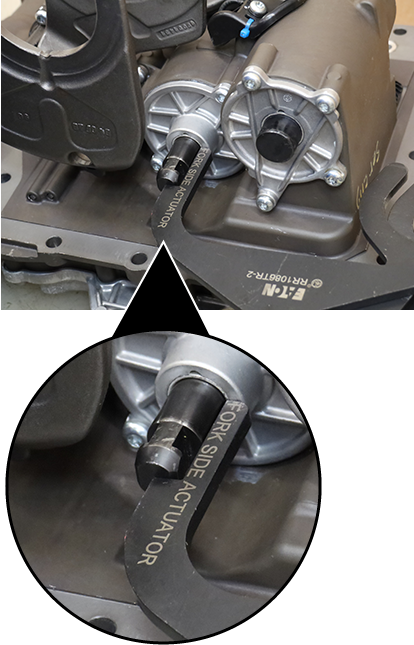
Slide new I-Brake MTM to Main Housing O-ring (13653) over the MTM front alignment pin on the main housing until fully seated in the groove.

Clean the sealing surfaces on the Main Housing and MTM Housing with gasket remover and a plastic scraper. Let air dry then wipe with a clean dry cloth
Apply Gasket Sealant with a bead width of 1.4-2.4 mm (0.055-0.094 inch) to the transmission housing sealing surface following the pattern below.
NoticeNote: Parts must be assembled within 10 minutes of applying Gasket Sealant.
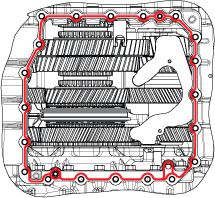
Install MTM onto the transmission housing. Align Rail E in the MTM with the Rail E Shift Rail in the Main Housing.
CautionNoticeInstall 20 MTM cap screws and torque to 44.5-51.5 Nm (33-38 lb-ft) in a criss-cross pattern.
Note: 13 mm (x18), 15 mm (x2) cap screws.
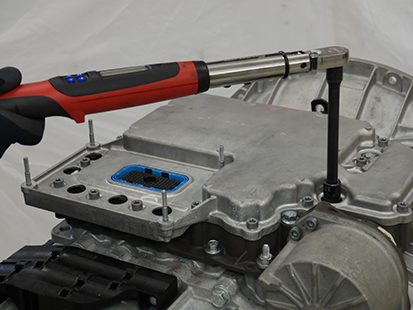
Install Output Speed Sensor
Clean the sensor bore.
NoticeApply a light coat of transmission oil to the sensor O-ring.
Install the Output Speed Sensor into the bore.
Note: The Sensor may need to be twisted and pushed into the bore.
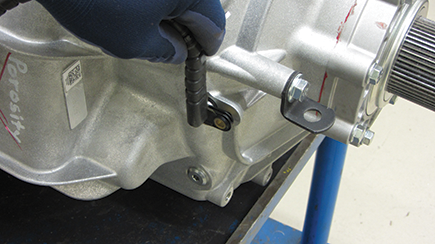
Install the Output Speed Sensor 10 mm cap screw and torque to 8.8-10.4 Nm (6-8 lb-ft).
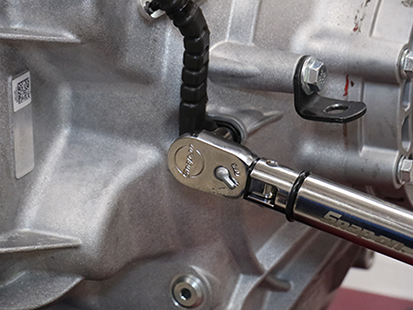
Press the 2 harness press-in retainers into the Main Housing and the bracket on the rear housing.
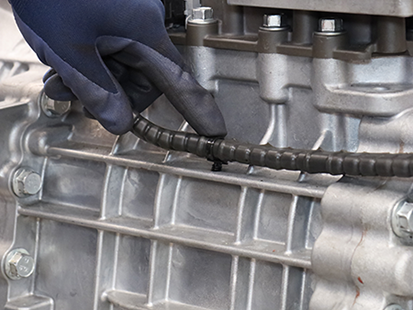

Secure the Output Speed Sensor Harness to the Harness Bracket with a tie strap.
Caution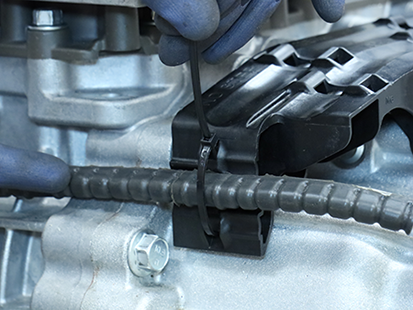
Connect Output Speed Sensor
Connect the Output Speed Sensor Harness to the Connector on the Mechatronic Transmission Module (MTM) and close the latch.

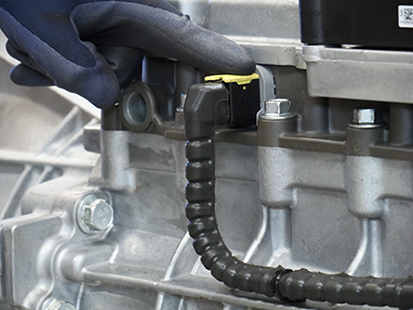
Install Transmission Control Module (TCM)
Install the TCM Seal on the 74-Way Harness Connector.

Align the TCM to the 74-Way Harness Connector and TCM studs and install the TCM.
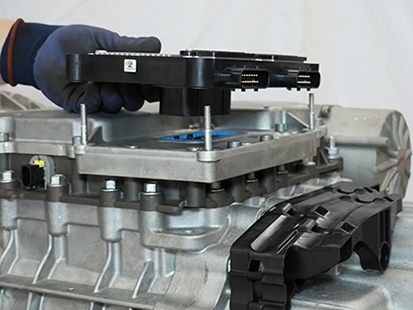
Torque the TCM 7 mm Jackscrew to 3.0-4.0 Nm (26.6-35.4 lb-in).

Install the TCM Cover over the 4 TCM studs and torque the 4 TCM Cover Nuts to 8.8-10.4 Nm (78-92 lb-in) in a criss-cross pattern.
Note: TCM Cover nuts are 10 or 13 mm.

Remove the Linear Clutch Actuator (LCA)
Loosen the 4 LCA cap screws 1-2 turns each with a T45 Torx.
NoticeNote: Residual air pressure in the LCA cylinder exhausts between the LCA and MTM housing when the cap screws are loosened.
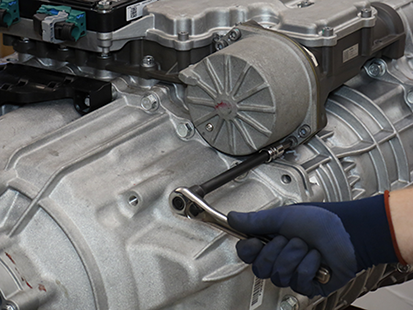
Remove the 4 LCA cap screws
Remove the LCA from the MTM.
Note: LCA piston rod end is seated in the release yoke socket; pull to release rod end from socket.
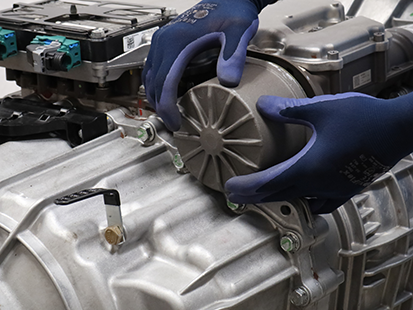
Inspect the plastic socket insert in the release yoke through the LCA opening using a flashlight to verify none of the fingers are missing or damaged.
Note: If the plastic insert is damaged, replace the release yoke assembly.
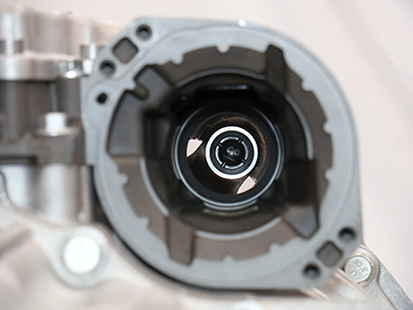
Reset and Install Linear Clutch Actuator (LCA)
Inspect LCA to determine next steps, reference images below:
- If LCA is locked in the reset position, go to Install Linear Clutch Actuator (LCA).
- If LCA is not locked in the reset position, go to Step 2.
Locked in Reset Position
Not Locked in Reset Position
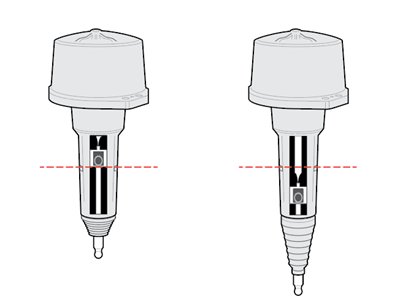
Place LCA push rod on a clean, flat surface. Tightly grasp LCA housing with both hands and push down on push rod to lock LCA into the reset position.
Caution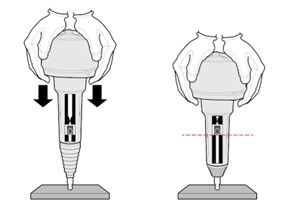
Inspect LCA to determine next steps, reference images below:
- If LCA remains locked in the reset position, go to Step 4.
- If LCA does not remain locked in the reset position, go to Step 2, repeat reset procedure.
Note: If LCA cannot be locked into the reset position, replace LCA.
CautionLocked in Reset Position
Not Locked in Reset Position
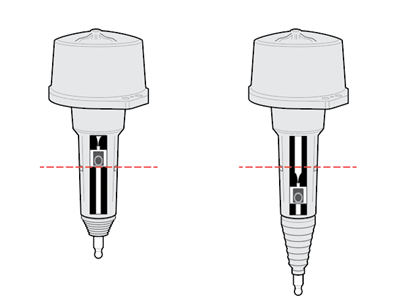
Clean all sealing surfaces on the MTM and LCA with a lint free cloth.
NoticeInsert the LCA into the MTM.
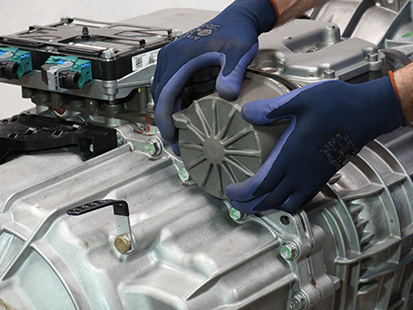
Install 4 LCA T45 cap screws and torque to 23-28 Nm (17-21 lb-ft) in a criss-cross pattern.
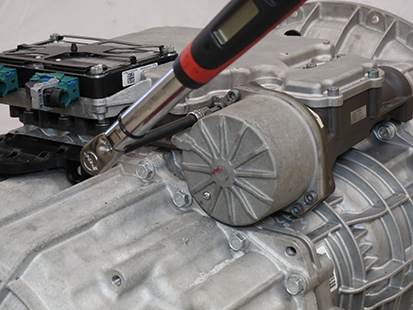
Install the Release Bearing and Clutch Release Yoke
Install the upper Release Yoke socket over the rod end of the Linear Clutch Actuator (LCA) and press until attached.

Install the lower Release Yoke socket over the lower pivot on the clutch housing and press until attached.
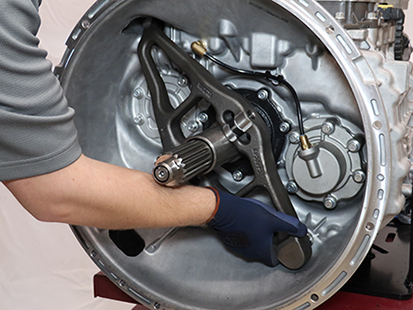
Slide the Release Bearing over the input shaft and into the Release Yoke.

Install Transmission
Refer to OEM guidelines for transmission installation.
Connect negative battery cable.
Fill Oil
Note: Perform the transmission fill procedure with transmission installed in vehicle to ensure proper transmission angle.
Remove the Oil Fill Plug with a 6 mm hex key.

Place a suitable container under the Oil Check Plug and remove the Oil Check Plug with a 6 mm hex key.

Fill the transmission with PS-386 lube until a small amount of oil runs out of the Oil Check Plug hole.
Note: Fill capacity is approximately 7.5-8.5 liters (16-18 pints) depending on the transmission angle.
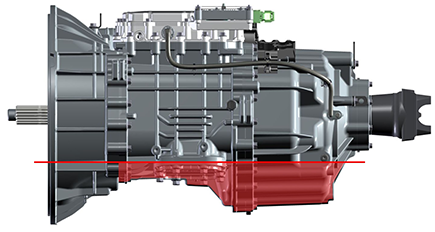
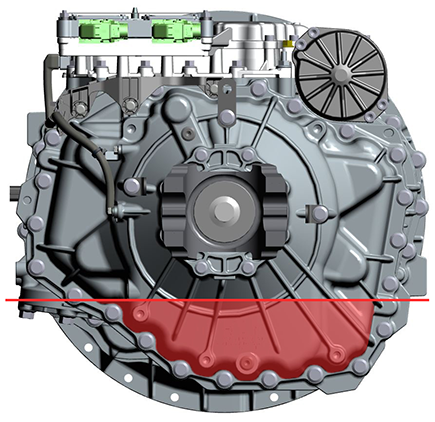
Inspect Oil Check Plug and O-ring for damage. If damaged, replace the Oil Check Plug; O-ring is serviced with plug.
Install the Oil Check Plug (6 mm) and torque to 24.5-29.5 Nm (18-22 lb-ft).
Notice
Inspect Oil Fill Plug and O-ring for damage. If damaged, replace the Oil Fill Plug; O-ring is serviced with plug.
Install the Oil Fill Plug (6 mm) and torque to 24.5-29.5 Nm (18-22 lb-ft).
Notice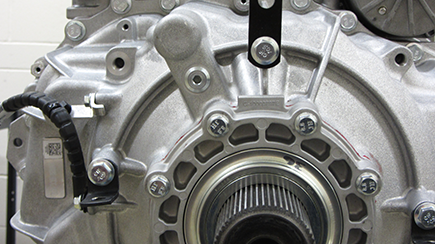
Connect the negative battery cable.
Clutch and Rail Calibration
To ensure proper operation, the TCM, clutch, MTM and transmission require a Clutch and Rail Calibration. Calibrations are automatically initiated when:
- LCA is in the reset position
- Transmission in “N” (Neutral)
- Key on engine running
- Vehicle air system pressure at operating range
Note: Vehicle display may indicate a flashing “CC” and “F” in gear display.
Set vehicle parking brake and chock wheels.
Ensure the driveline is connected between the transmission and axle.
Note: Clutch and Rail Calibrations cannot complete if the transmission output shaft is allowed to rotate.
Key on with engine running.
Allow vehicle air pressure to build to governor cut-off.
Note: Clutch and Rail Calibrations automatically initiate when vehicle air pressure reaches approximately 100 psi.
Ensure “N” (Neutral) is selected and engine is running. Wait approximately 2 minutes for calibrations to complete.
Notice- If vehicle display indicates a solid “N: (Neutral) in gear display, calibrations are complete. Key off, go to Step 6.
- If vehicle display continues to indicate a flashing “CC” and/or “F” in gear display or service transmission message, go to Step 5.
Key off and wait 1 minute.
Key on with engine off.
Connect ServiceRanger.
Go to “Fault Codes”.
- If an Active transmission fault code is set, go to Endurant HD Troubleshooting Guide TRTS0950 Diagnostic Procedure.
- If no Active transmission fault codes are set, select “Clear Eaton Faults” and follow on-screen prompts. Go to Step 9.
Disconnect ServiceRanger.
Key off.
Inspect transmission for a PTO.
- If not PTO-equipped, process complete.
- If PTO-equipped, start the engine and run for 1 to 2 minutes to fill the PTO with oil, key off and repeat the Fill Oil Procedure.
Caution